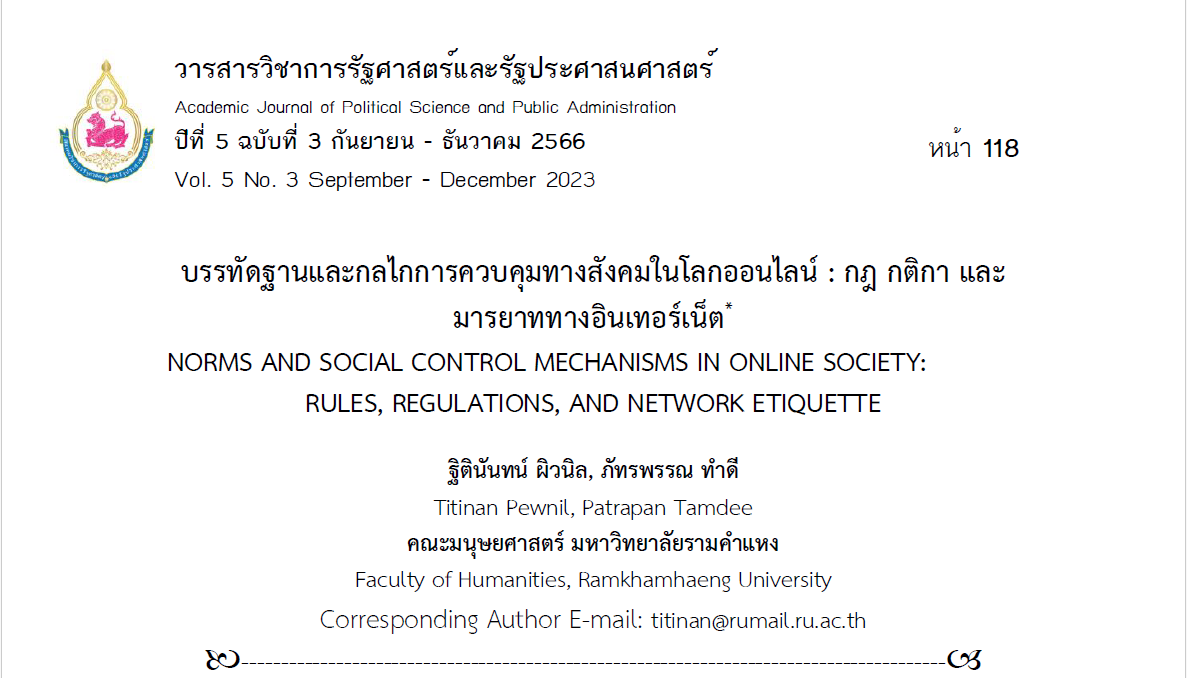บรรทัดฐานและกลไกการควบคุมทางสังคมในโลกออนไลน์ : กฎ กติกา และมารยาททางอินเทอร์เน็ต
คำสำคัญ:
การควบคุมทางสังคม, สังคมออนไลน์, บรรทัดฐานสังคมบทคัดย่อ
บทความวิชาการนี้มีวัตถุประสงค์เพื่อทำความเข้าใจต่อบรรทัดฐานทางสังคมในโลกออนไลน์ ตลอดจนกลไกในการควบคุมทางสังคมผ่านการบังคับใช้กฎ กติกา และมารยาททางอินเทอร์เน็ตทั้งที่ดำเนินการโดยผู้ให้บริการและผู้ใช้งานในโลกออนไลน์ โดยมีความเชื่อมโยงกับบรรทัดฐานทางสังคมในโลกทางกายภาพทั้งบรรทัดฐานในระดับสากลที่ยอมรับร่วมกันในระดับนานาชาติ และบรรทัดฐานในระดับท้องถิ่นในแต่ละสังคมซึ่งส่วนใหญ่ให้ความสำคัญในประเด็นด้านความปลอดภัย ความเป็นส่วนตัว การใช้ถ้อยคำแสดงความเกลียดชัง และการคัดกรองเนื้อหาเกี่ยวกับความรุนแรง โดยปรับเปลี่ยนไปตามสถานการณ์ทางสังคม เมื่อมีการละเมิดกฎเกณฑ์ในเบื้องต้นจึงถือเป็นความรับผิดชอบของผู้ดูแลแพลตฟอร์มเพื่อดำเนินการด้วยบรรทัดฐานที่เป็นทางการซึ่งอาจยังไม่เพียงพอและไม่ทั่วถึง จึงต้องอาศัยกลไกการควบคุมทางสังคมโดยชุมชนผู้ใช้งานร่วมกันเสนอแนะ วิจารณ์ รายงานปัญหา ตลอดจนสอดส่องและจัดการกับพฤติกรรมที่ไม่เหมาะสมและไม่สอดคล้องกับมารยาทการใช้งานทางอินเทอร์เน็ตด้วยการตำหนิและวิพากษ์วิจารณ์ทันทีบนพื้นที่สาธารณะ แต่อาจนำไปสู่ความขัดแย้งหากไม่สามารถควบคุมได้ บรรทัดฐานและการควบคุมทางสังคมบนโลกออนไลน์จึงมีลักษณะเป็นพลวัตปรับเปลี่ยนไปตามสถานการณ์ โดยมีแนวโน้มที่จะยืดหยุ่นมากกว่าแต่ไม่ได้แยกขาดออกจากบรรทัดฐานและการควบคุมทางสังคมในโลกทางกายภาพแต่อย่างใด
เอกสารอ้างอิง
คุณากร คงจันทร์ และคณะ. (2564). มารยาทการสื่อสารผ่านสื่อสังคมออนไลน์ของคนไทย. วารสารปาริชาติ, 34(1), 155-175.
จักรกฤษณ์ วรวีร์ และคณะ. (2565). ปัญหาการบังคับใช้กฎหมายเกี่ยวกับการระรานทางไซเบอร์. วารสารวิชาการสถาบันวิทยาการจัดการแห่งแปซิฟิค สาขามนุษยศาสตร์และสังคมศาสตร์, 8(3), 324-338.
จุลนี เทียนไทย และคณะ. (2564). การสร้างความเข้าใจในคุณลักษณะ พฤติกรรม และทัศนคติในอนาคตของชาวดิจิทัลไทย. กรุงเทพฯ: สำนักงานการวิจัยแห่งชาติ.
เปรมฤดี เพ็ชรกูล. (2561). แนวคิดการทำให้อับอายทางออนไลน์และแนวทางเพื่อลดปัญหาการตีตราทางสังคม. วารสารวิชาการมหาวิทยาลัยฟาร์อีสเทิร์น, 12(3), 9-23.
สุวิพร ไฉไลสถาพร และคณะ. (2560). ประสบการณ์และแนวทางการเผชิญปัญหาของเด็กและเยาวชนไทยที่ตกเป็นเหยื่อการกลั่นแกล้งทางไซเบอร์. วารสารวิจัยและพัฒนาหลักสูตร, 7(2), 215-234.
อานุรักษ์ เขื่อนแก้ว, และอัจฉรา ปัณฑรานุวงศ์. (2563). พื้นที่การแสดงออกต่อข่าวเกี่ยวกับความรุนแรงในเฟซบุ๊กแฟนเพจประเภทข่าว. วารสารศาสตร์, 13(2), 74-129.
Benesch, S. (2020). But Facebook's Not a Country: How to Interpret Human Rights. Retrieved November 30, 2020, from https://www.yalejreg.com/
bulletin/but-facebooks-not-a-country-how-to-interpret-human-rights-law-for-social-media-companies/.
Helberger, N., Pierson, J., & Poell, T. (2018). Governing Online Platforms: From Contested to Cooperative Responsibility. The Information Society, 34(1), 1-14.
Kendall, D. (2012). Sociology In Our Times: The Essentials. Retrieved November 19, 2022, from http://www.sociology.org.uk/notes/
Soctimes.pdf
Kettemann, M. C. (2020). The Normative Order of the Internet: A Theory of Rule and Regulation Online. Oxford: Oxford University Press.
Kiesler, S., & Kittur, N. (2007). Norms in Online Communities. Retrieved November 19, 2022, from https://people.eng.unimelb.edu.au/ vkostakos/courses/socialweb10F/reading_material/5/Kiesler07.pdf
Klonick, K. (2016). Re-shaming the Debate: Social Norms, Shame, and Regulation in an Internet Age. Maryland Law Review, 75(4), 1029-1065.
Line Corporation. (2022). LINE Terms and Conditions of Use. Retrieved September 10, 2023, from https://terms.line.me/line_terms?lang=en.
Meta. (2023a). Facebook Community Standards. Retrieved September 10, 2023, from https://transparency.fb.com/policies/community-standards/.
Meta. (2023b). Instagram Community Guidelines. Retrieved September 10, 2023, from https://help.instagram.com/477434105621119/? helpref=hc_fnav&cms_id=477434105621119
PANTIP.COM. (2023). กฎ กติกา และมารยาท. สืบค้น 10 กันยายน 2566, จาก https://pantip.com/about/tos
Pattaro, E., & Sartor, G. (2002). Norms, Laws, and the Internet. Retrieved October 14, 2022, from https://citeseerx.ist.psu.edu/document? repid=rep1&type=pdf&doi=b0e417deb977ddf52e511c4ac0591445a643bcd0
Pettersen, L. (2016). The Role of Offline Places for Communication and Social Interaction in Online and Virtual Spaces in the Multinational Workplace. Nordicom Review, 37, 131-146.
Rost, K., Stahel, L., & Frey, B. S. (2016). Digital Social Norm Enforcement: Online Firestorms in social media. PLoS One, 11(6), e0155923.
Svensson, M. (2013) "Norms in Law and Society: Towards a Definition of the Socio-Legal Concept of Norms". In Baier, M. (ed.) Social and Legal Norms. London: Ashgate.
TikTok. (2023). Community Principles. Retrieved September 10, 2023, from https://www.tiktok.com/community-guidelines/en/ community-principles/
X. (2023). The X Rules. Retrieved September 10, 2023, from https://help.twitter.com/en/rules-and-policies/x-rules.
Youtube. (2023). Community Guidelines. Retrieved September 10, 2023, from https://www.youtube.com/intl/th/howyoutubeworks/policies/community-guidelines/.

ดาวน์โหลด
เผยแพร่แล้ว
รูปแบบการอ้างอิง
ฉบับ
ประเภทบทความ
หมวดหมู่
สัญญาอนุญาต
ลิขสิทธิ์ (c) 2023 วารสารวิชาการรัฐศาสตร์และรัฐประศาสนศาสตร์

อนุญาตภายใต้เงื่อนไข Creative Commons Attribution-NonCommercial-NoDerivatives 4.0 International License.




